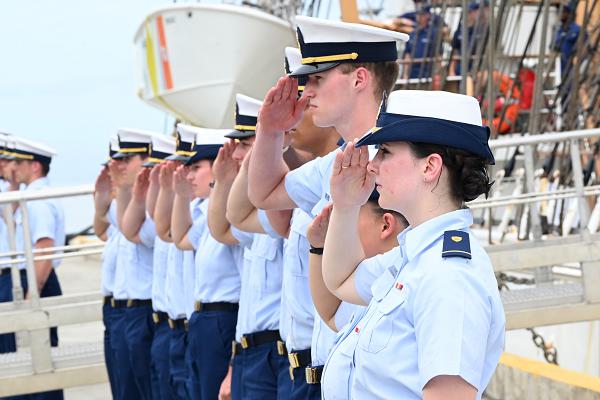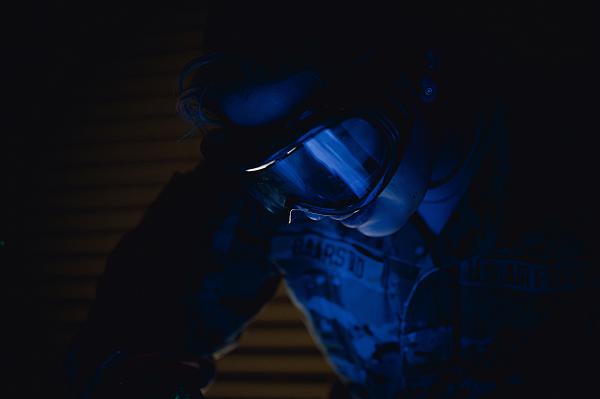- Details
- Hits: 839

Camp Pendleton, California. (June 9, 2024): Former United States Marine Corps General and Secretary of Defense James “Bull Dog” Mattis referred to them as “Little Sparta” for their ability to punch above their weight. In this photo by Lance Corporal Alexis Ballin, U.S. Marine Corps Corporal Ender Wichlacz, left, a team leader with 3rd Battalion, 1st Marine Regiment, 1st Marine Division, hikes alongside members of the United Arab Emirates Presidential Guard. These elite Arab troops, although coming from a tiny Gulf nation, are some of the toughest warfighters in the business.
The Emirati troops joined the Marines to train in reconnaissance, counterinsurgency, and small unit tactics. The goal is to practice coordinating forces as they would in combat. UAE forces took part in Operation Desert Storm in 1990 where they lost ten soldiers helping liberate Kuwait. They also sent troops to Afghanistan and have contributed to numerous peacekeeping missions including Kosovo, Lebanon, and Somalia. Recently, the UAE armed forces joined U.S. and Saudi forces seeking to track down Al Qaeda terrorists in neighboring Yemen.
The UAE armed forces have a Navy with two thousand Sailors operating seventy-two vessels and a four thousand strong Air Force. The UAE purchases a variety of aircraft from allied countries France (Mirage 2000), Great Britain (Hawk Aircraft), and the U.S. (F-16s). Their Army is comprised of eight brigades: two armored, three mechanized, two infantry, and three regiments of artillery. Many of their officers are graduates of the U.S. Military Academy at West Point.
Tiny but tough, America can count on this close ally to be there when we need them.
- Details
- Hits: 697

Lima, Peru. (June 19, 2024): America’s big heart was on display this week during Exercise Resolute Sentinel 2024, a joint exercise involving U.S. and local forces from host countries Peru, Brazil, Chile, Colombia, and Ecuador. In this photo by Technical Sergeant Devin Boyer, Air Force Lieutenant Colonel Kim Broughton (left) conducts leg surgery alongside Peruvian surgeons as part of humanitarian and disaster preparedness exercises.
Hosted by the U.S. Southern Command, Resolute Sentinel 2024 is both a training event and a chance to forge critical relationships that will be vital in any future emergency. Some 1,500 American medical personnel trained with their local counterparts on everything from disaster response and medical readiness to cyber defense and small arms combat tactics. This year, special emphasis was placed on medical readiness with joint medical teams operating field hospitals to provide care to local communities.
The primary goal of the training is to enhance America’s ability to respond collectively to natural disasters such as earthquakes, hurricanes and floods, which are prevalent in the region.
- Details
- Hits: 852

Joint Base Elmendorf-Richardson, Alaska. (June 17, 2024): It is the difference between taking a course on something and dedicating your career to the subject. That is the case with Air Force Joint Terminal Attack Controllers and what civilians call a “foreword observer.” In this photo by Senior Airman Julia Lebens, Technical Sergeant Gabriel Pillcurima, a joint terminal attack controller assigned to Detachment 1, 3rd Air Support Operations Squadron, practices his craft of guiding attack aircraft for the Air Force. The Air Force offers careers in close air support, far beyond mere certification as a controller.
Sergeant Pillcurima is part of a Tactical Air Control Party, commonly abbreviated TACP, comprised of a small team of military personnel who provide coordination between aircraft and ground forces when providing close air support. His squadron is part of Air Force Pacific and trains, equips and deploys these teams to support elements of the 11th Airborne Division (previously United States Army Alaska ) and its 1st Infantry Brigade Combat Team at Fort Wainwright, Alaska.
A part of Air Force Special Warfare, these parties embed with Army and Marine units on the frontline to call in air strikes on the enemy. Additionally, TACPs advise ground commanders on the best use of air power, establish communications, and deliver precision terminal attack guidance for close air support aircraft, artillery, and naval gunfire.
These teams operate with special forces including the Army’s Rangers, Navy SEALS, and members of the Special Operations Command. Air Force TACPs attend the Special Warfare Preparatory Course, Airborne School, and Survival, Evasion, Resistance & Escape (SERE) training before earning their certifications.
- Details
- Hits: 763

Naval Base San Diego, California. (June 17, 2024): “Surely, beekeeping can’t be a military occupation,” asked a representative of Support Our Troops of public affairs officials at the base here. We had hoped to interview Lieutenant Junior Grade Kaylee Newcomb, pictured above in her protective equipment removing bees from the USS Tripoli. (Photo by Seaman Recruit Eliora Sims). America’s enormous warships provide an attractive place for bees to establish their hives but naturally this can be a threat to crew safety.
What is astonishing is that Newcomb, a cyber warfare officer aboard an assault ship, would have the knowledge, equipment, and skills to move a swarm of bees safely to their new location.
Is there a class at Cyber School for bee removal?
Having not heard from Lieutenant Newcomb, we decided to do some digging on our own and learned a lot about bees in the process. Interestingly, bees are very aware of and loyal to their hive and it takes some pushing to make them want to leave. There is a saying among bee types that you can move a hive “three feet or three miles” and they will find their way home. If the distance is more than three miles, bees cannot recognize their location and must reorientate themselves to their unfamiliar environment. It is as if they wake up in a different landscape and GPS location which can be very disorienting for our bee friends.
Bees are so attached to the location of their hives that they pirouette as they leave the entrance, always keeping an eye on the way home. They fly in small figure eights in front of the hive gathering information about landmarks and the sun’s direction before they head out to forage for nectar, pollen, and water.
To move a hive, protective gear including a full bee suit, gloves, and a veil is an absolute must. If relocating a short distance, it is not necessary to cover the entrance as the bees will follow the hive to the new location easily. If longer distances are involved, there are a couple of considerations to preserve the health of a bee colony.
- Details
- Hits: 1207

Santa Domingo, Dominican Republic. (June 12, 2024): Every military branch has its unique “hell week” period of training to determine if someone really wants to serve. For potential Coast Guard officers, the torturous path begins with Swab Summer, an indoctrination period for new cadets to prepare them for a career at sea. In this photo by Petty Officer 1st Class Matthew West, Cadets from the Coast Guard Academy attend a welcoming ceremony aboard the Cutter Eagle. One of our nation’s oldest active tall ships, the Eagle, has trained Academy cadets since 1792. The tour aboard the Eagle teaches cadets basic seamanship, navigation, and the leadership skills they will need to take command.
Surviving Swab Summer, however, is no pleasure cruise.
The first phase is an intense seven-week basic training program designed to turn civilians into military servicemembers ready to defend their country. The program includes rigorous physical conditioning, seamanship fundamentals, and a well-rounded classical education. The Academy emphasizes teamwork, individual initiative, and the military values of honor, respect, and devotion to duty.
Swabs know they will be both physically and mentally tested.
Cadets run obstacle courses and complete team rope course challenges between units. They are taught basic sailing at the Jacobs Rock Seamanship and Sailing center and are expected to know Coast Guard history and their chain of command.
Swab Summer ends with “Sea Trials,” a thirteen-hour final examination that evaluates a Swab’s ability to perform as a Sailor and a leader. Cadets are evaluated on teamwork and perseverance as they face multiple stressful situations. There is a simulated shipwreck, for example, where Cadets are graded on their coolness under fire. The day begins at 3:30 a.m. with alarms sounding as Cadets grab their gear for an hour long round of calisthenics. Swabs spend the remainder of the day completing various tasks including road marches, river rafting, and they even carry a log around campus.
- Details
- Hits: 805

Tyndall Air Force Base, Florida. (June 15, 2024): In the fast-paced world of military aviation, aircraft parts suffer wear and tear that, if undetected, could cause a catastrophe. Aboard ships, there is little time to analyze aircraft parts for damage, especially for ‘destructive’ testing that requires dissolving materials into liquids. In this photo by Airman 1st Class Zeeshan Naeem, Airman 1st Class Gwynavere Baarstad, 325th Maintenance Squadron non-destructive inspection apprentice, checks a simulated aircraft part for damage. Traditional chemistry requires using acid to liquify a sample for analysis by Atomic Absorption or X-Ray Fluorescence (tools to measure the elemental content) that require the sample to be destroyed. Nondestructive testing (NDT), by contrast, is a multidisciplinary profession that blends quality assurance and materials science to inspect and evaluate materials without destroying their serviceability.
For the Air Force, this means using analytical methods like ultrasound, X-rays, and fluorescent dies to ensure aircraft components are operational and ready for the next mission. The goal of non-destructive inspection is to identify even the tiniest defect in systems or equipment that could become a danger to an aircraft. These highly skilled technicians use three primary methods to peer inside vital components, Ultrasonic Testing, Eddy Current Testing, and Radiographic Testing.
Expectant parents are familiar with the most used non-destructive tool to check aircraft parts for possible defects, the Ultrasound. Ultrasonic testing uses high-frequency sound waves to inspect for flaws in the thickness of a material without altering it chemically. When sound waves hit a defect, they bounce back to give a real time view of the interior of a sample.
Eddy Current Testing uses a conductive wire to create an electromagnetic current that is used to probe the surfaces of materials. These currents are extremely sensitive and can find even the minutest defect or flaw on the surface of a conductive material. Eddy currents are ideal for testing materials under extreme conditions such as underwater or on hot temperature surfaces.


